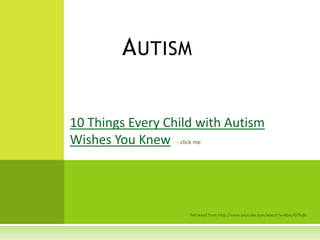
Autism goals and_monitoring2
- 1. Autism 10 Things Every Child with Autism Wishes You Knew- click me Retrieved from http://www.youtube.com/watch?v=AbeyIG7Fz8s
- 2. GOALS*to be altered for student differences with ASD Follow instructional prompts Participate in turn-taking Follow regular classroom routines Interact with peers Use/try to use communicative methods Transition in an adequate amount of time Understand what is unsafe
- 3. Monitoring Progress & Goals*to be altered for student differences with ASD Specific Directions Date: ____________ **Developed at the Experimental Education Unit University of Washington (Cognitive-Specific Directions) MCIU. (2011). Progress Monitoring. Specific directions. Retrieved from http://www.mciu.org/Divisions/SpecialEducation/EarlyInterventionOverview/Progress MonitoringTools/tabid/296/Default.aspx
- 4. Monitoring Progress & Goals*to be altered for student differences with ASD Turn-Taking Date: ____________ 0- Refusal 1- Full Physical 2- Partial Physical 3- Verbal/Gestural 4- Independent **Developed at the Experimental Education Unit University of Washington (Social-Turn-Taking) MCIU. (2011). Progress Monitoring. Turn-taking. Retrieved from http://www.mciu.org/Divisions/SpecialEducation /EarlyInterventionOverview/ProgressMonitoringTools/tabid/296/Default.aspx
- 5. Monitoring Progress & Goals*to be altered for student differences with ASD Routine/Transitions Date: ____________ 0 – Resistance/Refusal 1 – Independent 2 – Verbal/Gestural Prompt 3 – Partial Physical 4 – Full Physical **Developed at the Experimental Education Unit University of Washington (Routines and Directions-Routines/Transitions) MCIU. (2011). Progress Monitoring. Routines and transitions k. Retrieved from http://www.mciu.org/Divisions/SpecialEducation/EarlyInterventionOverview/ProgressMonitoringTools/tabid/296/ Default.aspx
- 6. Monitoring Progress & Goals*to be altered for student differences with ASD Cooperative Play Date: ____________ I – Independent G/V – Gestural/Verbal PP – Partial Physical Assistance FP – Full Partial Assistance R - Refusal **Developed at the Experimental Education Unit University of Washington (Social-Cooperative Play) MCIU. (2011). Progress Monitoring. Cooperative play. Retrieved from http://www.mciu.org/Divisions/SpecialEducation /EarlyInterventionOverview/ProgressMonitoringTools/tabid/296/Default.aspx
- 7. Monitoring Progress & Goals*to be altered for student differences with ASD Communicative Exchanges Date: ____________ 1 – Resistance/Refusal 2 – Physical Assistance 3 – Verbal Cue 4 - Independent **Developed at the Experimental Education Unit University of Washington (Communication-Communicative Exchange) MCIU. (2011). Progress Monitoring. Communicative exchanges. Retrieved from http://www.mciu.org/Divisions/SpecialEducation/EarlyInterventionOverview/ProgressMonitoring Tools/tabid/296/Default.aspx
- 8. Cooperative Techniques for Implementation*to be altered for student differences with ASD All assistive teachers will utilize worksheets Specific Directions Turn-Taking Routine/Transitions Cooperative Play Communicative Exchanges
- 9. STUDENT
- 10. Cooperative Techniques for Implementation*to be altered for student differences with ASD Allen and Cowdery (2005) suggest the following for working as a team for children with autism “Keep messages simple and direct” (p. 154) “Use objects and actions along with words” (p. 154) “Emphasize spoken language by having the child ask for something by name whenever possible” (p. 154) “Give the child opportunities to interact with nondisabled who are at a more comparable level in language and social development” (p. 154) “Establish a predictable environment” (p. 154) “Provide opportunity for the child to generalize new skills by ensuring the opportunity to practice these skills in a variety of settings” (p. 154) “Focus on improving the child’s communication skills” (p. 154) “Provide frequent communication with parents and other care providers” (p. 155) Allen, K.E., & Cowdery, G.E. (2005). The exceptional child: Inclusion in early childhood education (5th ed.). Clifton Park, NY: Thomson Delmar Learning.
- 12. General classroom teacher possesses all cumulative records by all interdisciplinary team members as well as being kept in students main file
- 13. General classroom teacher will record observation on at least 2 worksheets per week with other interdisciplinary team members recording observations at least once every 2 weeks
- 14. Have all interdisciplinary team members participate in worksheets
- 16. Turn-Taking
- 18. Cooperative Play